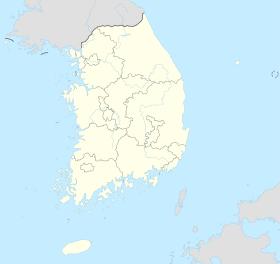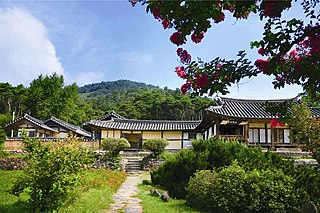
South Chungcheong Province, also known as Chungnam, is a province of South Korea in the Hoseo region in the southwest of the Korean Peninsula. South Chungcheong borders the provinces of Gyeonggi to the north, North Chungcheong, Sejong Special Self-governing City, and Daejeon Metropolitan City to the east, and North Jeolla to the south.

Cheongju is the capital and largest city of North Chungcheong Province in South Korea.

Namwon is a city in North Jeolla Province, South Korea. Namwon is about 50 minutes from the provincial capital of Jeonju, which is almost three hours away from Seoul. The official city flower is Royal Azalea (철쭉) while the city tree is the crape-myrtle (배롱나무) and the city bird is the swallow (제비). Namwon is a small city located just outside Jirisan National Park, which has the largest set of mountains on the South Korean Mainland. It also borders the Seomjin River, one of South Korea's more prominent rivers. It is 3 hours and 15 minutes from the Seoul Central City Bus Terminal and about one hour from both the U-Square Bus Terminal in Gwangju and the Jeonju Inter City Bus Terminal. It is called "the City of Love" because of the famous Korean love story of Chunhyang. Gwanghanlu Garden is a shrine to this love story.

South Korea is made up of 22 first-tier administrative divisions: 6 metropolitan cities, 1 special city, 1 special self-governing city, and 14 provinces, including three special self-governing provinces and five claimed by the ROK government. These are further subdivided into a variety of smaller entities, including cities, counties, districts, towns, townships, neighborhoods and villages.

Anseong is a city in Gyeonggi Province, South Korea, 80 kilometres (50 mi) south of Seoul. Its geographical location is 37°0′N127°16′E.

Guri is a city in Gyeonggi Province, South Korea. It is located immediately to the east of Seoul, in the heart of the Capital Metropolitan Area.

Paju is a city in Gyeonggi Province, South Korea. Paju was made a city in 1997; it had previously been a county (gun).

Asan is a city in South Chungcheong Province, South Korea. It borders the Seoul Capital Area to the north. Asan has a population of approximately 300,000.

Boryeong, commonly known as Daecheon, is a city in South Chungcheong Province, on the western coast of South Korea. Boryeong is known around Korea for its beaches, particularly Daecheon Beach, and the annual Boryeong Mud Festival around July. The city's beach-mud is widely touted for its cosmetic properties. As elsewhere along the southwest coast of the Korean peninsula, there are numerous small islands, many of which are connected by ferry to Daecheon Port.
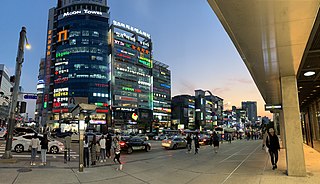
Cheonan is the largest and most densely populated city of Chungcheongnam-do, South Korea, and the third largest city in the Hoseo region after Daejeon and Cheongju. Cheonan borders Gyeonggi-do in the north, Chungcheongbuk-do to the east and southeast, Sejong City to the south and Asan-si and Gongju-si to the west and southwest.

Mungyeong is a city in North Gyeongsang Province, South Korea. The local government, economy, and transportation networks are all centered in Jeomchon, the principal town. Mungyeong has a lengthy history, and is known today for its various historic and scenic tourist attractions. The city's name means roughly "hearing good news." Recently, development has been somewhat stagnant with the decline of the coal industry. Since the 1990s, the proportion of people who rely on the tourism industry through Mungyeong Saejae has gradually increased.
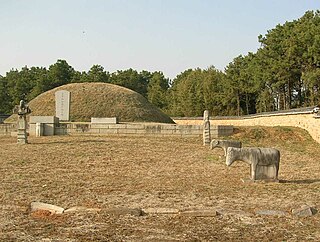
Sangju is a city in North Gyeongsang Province, central South Korea. Although Sangju is rather rural, it is very old and was once a key city. Along with Gyeongju, it gives rise to half of the name of the Gyeongsang provinces. Sangju is nicknamed Sam Baek, or "Three Whites", referring to three prominent agricultural products rice, silkworm cocoons, and dried persimmons from the area.
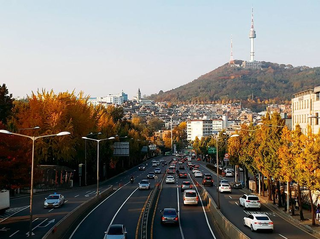
Yongsan District is one of the 25 districts of Seoul, South Korea.
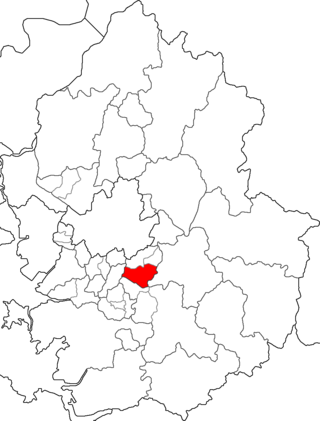
Bundang District (Korean: 분당구) is the largest and most populous district (gu) of Seongnam, a major city in the Seoul Capital Area, South Korea. Bundang District is one of South Korea's wealthiest and highest developed areas, being the nation's first and largest completely artificial city built in the early 1990s. Many high-rise luxury condos moved in the early 2000s, with a second planned city built in the late 2000s called Pangyo in the same district. Apartment prices are the second highest in Gyeonggi Province after Gwacheon and 7th highest nationwide, higher than many central Seoul districts such as Mapo District or Jongno District. Apartments around Pangyo station and the high-rise luxury condos around Jeongja station and Sunae station rival prices in the most expensive areas in the country. Unlike older cities such as Seoul, Bundang has no telephone poles overground, resulting in a clean cityscape with well-designed streets.
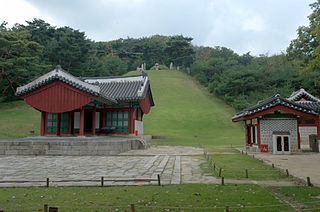
Seongbuk District is one of the 25 districts of Seoul, South Korea. The district is located in the mid-north part of the city. The current mayor is Kim Young-bae (김영배), who has been mayor since July 1, 2010. Seongbuk-gu was established under Presidential Decree No. 159 on August 13, 1949, and was promoted to a autonomous district by implementing a Gu-level local government on May 1, 1988.

Cheonan–Asan station is a ground-level train station located mostly in Asan, Chungcheongnam-do, although part of it lies in the neighboring city of Cheonan. This station serves high-speed KTX trains that run from Seoul to either Busan or Mokpo. It is connected to Asan station, a railway station on the Janghang Line which is also served by Line 1 of the Seoul Subway.

Seojeongni Station is a station in Seojeong-dong, Pyeongtaek, South Korea. Mugunghwa-ho trains running on the Gyeongbu Line stop here. Additionally, services on Seoul Subway Line 1 have been calling at this station since 2005. Its station subname is Kookje College.
천안여자고등학교, often referred to simply as Cheonan Yeogo in Korean, is a South Korean Public School for girls aged 15 to 18. It was founded in 1952.

Geumseong is a dong (neighborhood) in Geumjeong District, Busan, South Korea. A lightly populated district, it is situated entirely within the mountain range of Geumjeongsan. It is bounded to the west by Hwamyeong-dong and Geumgok-dong in Buk District, to the northwest by Dong-myeon of Yangsan City, to the east by Cheongnyong-dong, Namsan-dong, Guseo-dong, and Jangjeon-dong of Geumjeong District, and to the south by Oncheon-dong in Dongnae District. The northernmost point in Geumseong-dong is at Godang-bong, the highest peak in Geumjeongsan.

Seosaeng-myeon is a myeon of Ulju County, Ulsan, South Korea. As of 2022, its total population is 8,650.

